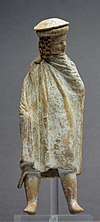Kingdom of Macedonia
| Macedonia | ||||||||||||||||
| Μακεδονία | ||||||||||||||||
|
||||||||||||||||
|
The Kingdom of Macedonia in 336 BC (orange)
|
||||||||||||||||
| Capital |
Aigai (Vergina) (808–399 BC) Pella (399–167 BC) |
|||||||||||||||
| Languages |
Ancient Macedonian, Attic Greek, Koine Greek |
|||||||||||||||
| Religion | Greek Polytheism, Hellenistic religion | |||||||||||||||
| Government | Monarchy | |||||||||||||||
| King | ||||||||||||||||
| • | 808–778 BC | Caranus (first) | ||||||||||||||
| • | 179–168 BC | Perseus (last) | ||||||||||||||
| Legislature | Synedrion | |||||||||||||||
| Historical era | Classical Antiquity | |||||||||||||||
| • | Founded by Caranus | 808 BC | ||||||||||||||
| • | Vassal of Persia | 512/511–493 BC | ||||||||||||||
| • | Incorporated into the Persian Empire | 492–479 BC | ||||||||||||||
| • | Rise of Macedon | 359–336 BC | ||||||||||||||
| • | Conquest of Persia | 335–323 BC | ||||||||||||||
| • | Partition of Babylon | 323 BC | ||||||||||||||
| • | Wars of the Diadochi | 322–275 BC | ||||||||||||||
| • | Battle of Pydna | 168 BC | ||||||||||||||
| Currency | Tetradrachm | |||||||||||||||
|
||||||||||||||||
 |
 |
|
Terracotta statues depicting ancient Macedonians wearing the kausia, a headgear that led the Persians to refer to the Macedonians as "Yaunã Takabara" ("Greeks with hats that look like shields"). Left: Athenian terracotta figurine, c. 300 BC Right: Macedonian terracotta figurine, 3rd century BC |
|
Macedonia or Macedon (/ˈmæsɪˌdɒn/) was an ancient kingdom on the periphery of Archaic and Classical Greece, and later the dominant state of Hellenistic Greece. The kingdom was founded and initially ruled by the royal Argead dynasty, which was followed by the Antipatrid and Antigonid dynasties. Home to the Ancient Macedonians, the earliest kingdom was centered on the northeastern part of the Greek peninsula, being bordered by Epirus to the west, Paeonia to the north, Thrace to the east and Thessaly to the south.
...
Wikipedia


